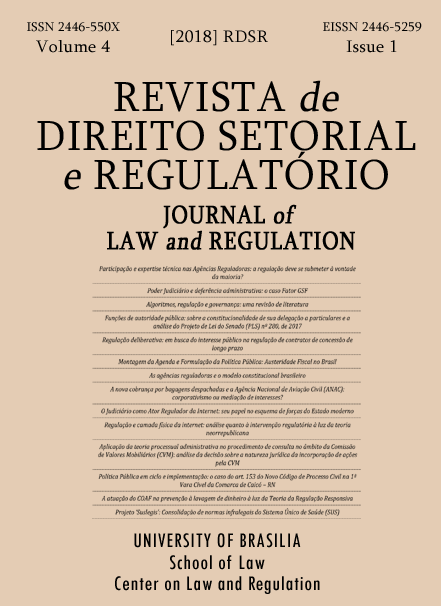Regulação e camada física da internet
análise quanto à intervenção regulatória à luz da teoria neorrepublicana
Palavras-chave:
regulação, camada, física, Internet, neorrepublicanismoResumo
Propósito ”“ Investigar possíveis reflexos das relações entre os detentores da camada física da Internet sobre a natureza aberta da rede mundial, avaliando o nível regulatório a ser estabelecido nesse contexto.
Metodologia/abordagem/design ”“ Inicialmente, o marco teórico será desenvolvido, explicitando-se as ideias neorrepublicanistas de Philip Petit e Cass Sunstein. Em seguida, serão apresentados conceitos estruturais para a compreensão dos acordos de interconexão. Após, será realizada revisão da literatura sobre os arranjos comerciais de interconexão e problematizada possível discrepância entre os valores que guiam as camadas física (econômico) e lógica (social) da Internet, avaliando-se o nível de intervenção regulatória necessário nesse cenário.
Resultados ”“ Os efeitos da evolução tecnológica sobre a camada física da Internet e os impactos do surgimento de novos tipos de arranjos comerciais de interconexão indicam que a intervenção regulatória sobre esse cenário deve existir, mas deve ser mínima e pontual, a fim de garantir transparência de informações e o incentivo à instalação de Pontos de Troca de Tráfego (PTT), estes como forma de ampliar as possibilidades e a diversidade da infraestrutura nesse setor.
Downloads
Referências
ALMEIDA, G. Neutralidade da Rede de desenvolvimento: o caso brasileiro. São Paulo, 2007, Diplo Foundation.
ARATA, S. Regulação pela Definição de Padrões Tecnológicos na Governança da Internet. Dissertação de Mestrado. Universidade de São Paulo ”“ USP, 2006.
BELTRÁN, F. Effects of ISP Interconnection Agreements on Internet Competition: The Case of the Network Access Point as a Cooperative Agreement for Internet Traffic Exchange. Center for Studies on Management of Network Services (CGSR). Universidad de Los Andes Bogotá, Colombia. Setembro, 2003. Disponível em: http://www.netinst.org/Beltran.pdf
CASTELLS, M. O Poder da Comunicação. São Paulo/Rio de Janeiro: Paz e Terra, 2015.
CARTER, M., & WRIGHT, J.. Asymmetric Network Interconnection. Review of Industrial Organization, 22(1), 27”“46. 2003. Disponível em: http://www.jstor.org/stable/41799139.
CLARK, D.; BAUER; STEVEN; LEHR, W.; CLAFFY, KC; DHAMDHERE, A. D.; HUFFAKER, B.; LUCKIE, M. Measurement and Analysis of Internet Interconnection and Congestion (September 9, 2014). 2014 TPRC Conference Paper. Available at SSRN: http://ssrn.com/abstract=2417573
CLARK, D.; LEHR, W.; BAUER, S. Interconnection in the Internet: The Policy Challenge (August 9, 2011). TPRC 2011. Available at SSRN: http://ssrn.com/abstract=1992641.
CLARK, D.; FARATIN, P.; BAUER, S.; LEHR, W. Complexity of Internet Interconnections: Technology, Incentives and Implications for Policy (August 15, 2007). TRC 2007. Available at SSRN: http://ssrn.com/abstract=2115242.
CLARK, D.; FARATIN, P.; BAUER, S.; LEHR, W.; GILMORE, P.; BERGER, A. The Growing Complexity of Internet Interconnection. Communications & Strategies, nº 72, 4th quarter 2008, p. 51-71.
COIMBRA, A. Republicanismo, instituições e a ingestão de normas internacionais por setores regulados brasileiros. Dissertação apresentada como requisito parcial à obtenção do grau de Mestre, no Programa de Pós-Graduação da Faculdade de Direito da Universidade de Brasília, área de concentração “Direito, Estado e Economia”. Brasília, 2011.
DENARDIS, L. Governance at the Internet’s Core: The Geopolitics of Interconnection and Internet exchange points in Emerging Markets. TPRC: 40th Research Conference on Communication, Information and Internet Policy, 2012.
_____. The global war for internet governance. Yale University Press, New Haven and London, 2014.
FRANSMAN, M. The New ICT Ecosystem: Implications for Policy and Regulation. Cambridge University Press: New York, 2010.
ISRAEL, M A.; BESEN, S. The Evolution of Internet Interconnection from Hierarchy to 'Mesh': Implications for Government Regulation (July 11, 2012). Available at SSRN: http://ssrn.com/abstract=2104323 orhttp://dx.doi.org/10.2139/ssrn.2104323.
KOVAC, A. M. Internet Peering and Transit. 2012. Disponível em http://www.broadbandforamerica.com/sites/default/themes/broadband/images/mail/AMKInternetPeeringandTransit_FINAL.pdf
KUROSE e ROSS. Redes de computadores e a Internet. Uma abordagem top-down. 3ª edição. São Paulo: Pearson Addison Wesley, 2006.
MEIER-HAHN, U. Creating Connectivity: Trust, Distrust and Social Microstructures at the Core of the Internet (September 4, 2015). TPRC 43: The 43rd Research Conference on Communication, Information and Internet Policy Paper; HIIG Discussion Paper Series No. 2015-03. Available at SSRN: http://ssrn.com/abstract=2587843or http://dx.doi.org/10.2139/ssrn.2587843.
PETTIT, P. Republicanism: a theory of freedom and government. Nova York. Oxford University Press, 2002.
RODRIGUES, C. L. Principais aspectos do neorrepublicanismo de Philip Pettit. Pensamento Plural. Pelotas [06]:35 ”“ 56, janeiro/junho 2010.
SUNSTEIN, C. Beyond the Republican Revival. Yale Law Journal, 1987-1988, p. 1539-90.
_____. After the Rights Revolution: Reconceiving the Regulatory State. Cambridge, MA: Harvard University Press, 1990.
_____. Free Markets and Social Justice. Oxford University Press, 1997.
UNIÃO EUROPEIA. Body of European Regulators for Eletronic Communications ”“ BEREC. Report. An assessment of IP interconnection in the context of Net Neutrality. Número do documento: BoR (12) 130. Data do documento: 06.12.2012. Tipo de documento: Consulta Pública.
VARGAS, D. B. O renascimento republicano no constitucionalismo contemporâneo e os limites da comunidade. Uma análise das teorias constitucionais de Bruce Ackerman, Frank Michelman e Cass Sunstein. Dissertação apresentada como requisito parcial à obtenção do grau de Mestre, no Programa de Pós-Graduação da Faculdade de Direito da Universidade de Brasília. Brasília, 2005.
Downloads
Publicado
Versões
- 2020-07-12 (2)
- 2018-05-15 (1)
Como Citar
Edição
Seção
Licença

Este trabalho está licenciado sob uma licença Creative Commons Attribution 4.0 International License.
Ao submeter seu artigo à Revista de Direito, Estado e Telecomunicações, declaro aceitar a licença de publicação Creative Commons Attribution 4.0 International (CC BY 4.0), disponível em http://creativecommons.org/licenses/by/4.0.


